The Influence of Leadership Styles on Organizational Creativity
VerifiedAdded on 2023/06/05
|14
|2652
|96
Report
AI Summary
This report delves into the significant influence of leadership styles, specifically transformational and situational approaches, on organizational creativity and innovation. It begins by establishing the importance of creativity in the modern business environment, emphasizing its role in problem-solving, cost-effective solutions, and competitive advantage. The report then reviews existing literature on creativity and leadership styles, defining and contrasting transformational and situational leadership. Section C analyzes how these leadership styles impact creativity, highlighting the role of transformational leaders in fostering disruptive innovation and the situational leaders' ability to adapt to changing circumstances. The report concludes with implications for practice, suggesting managerial training programs to promote transformational leadership while incorporating situational leadership traits to empower employees. It also highlights the need for knowledge management to prevent over-reliance on leaders and ensure sustained creativity.
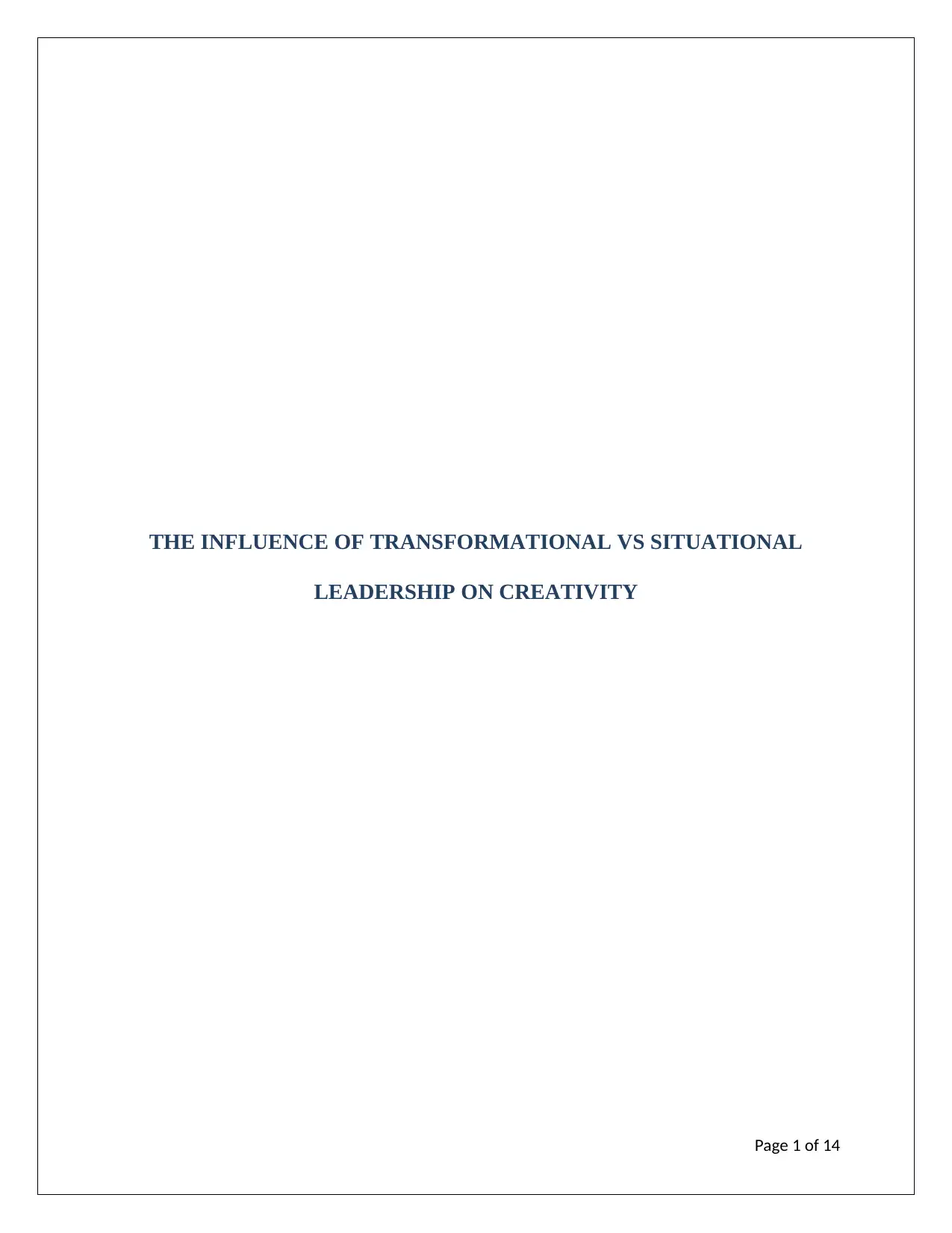
THE INFLUENCE OF TRANSFORMATIONAL VS SITUATIONAL
LEADERSHIP ON CREATIVITY
Page 1 of 14
LEADERSHIP ON CREATIVITY
Page 1 of 14
Paraphrase This Document
Need a fresh take? Get an instant paraphrase of this document with our AI Paraphraser
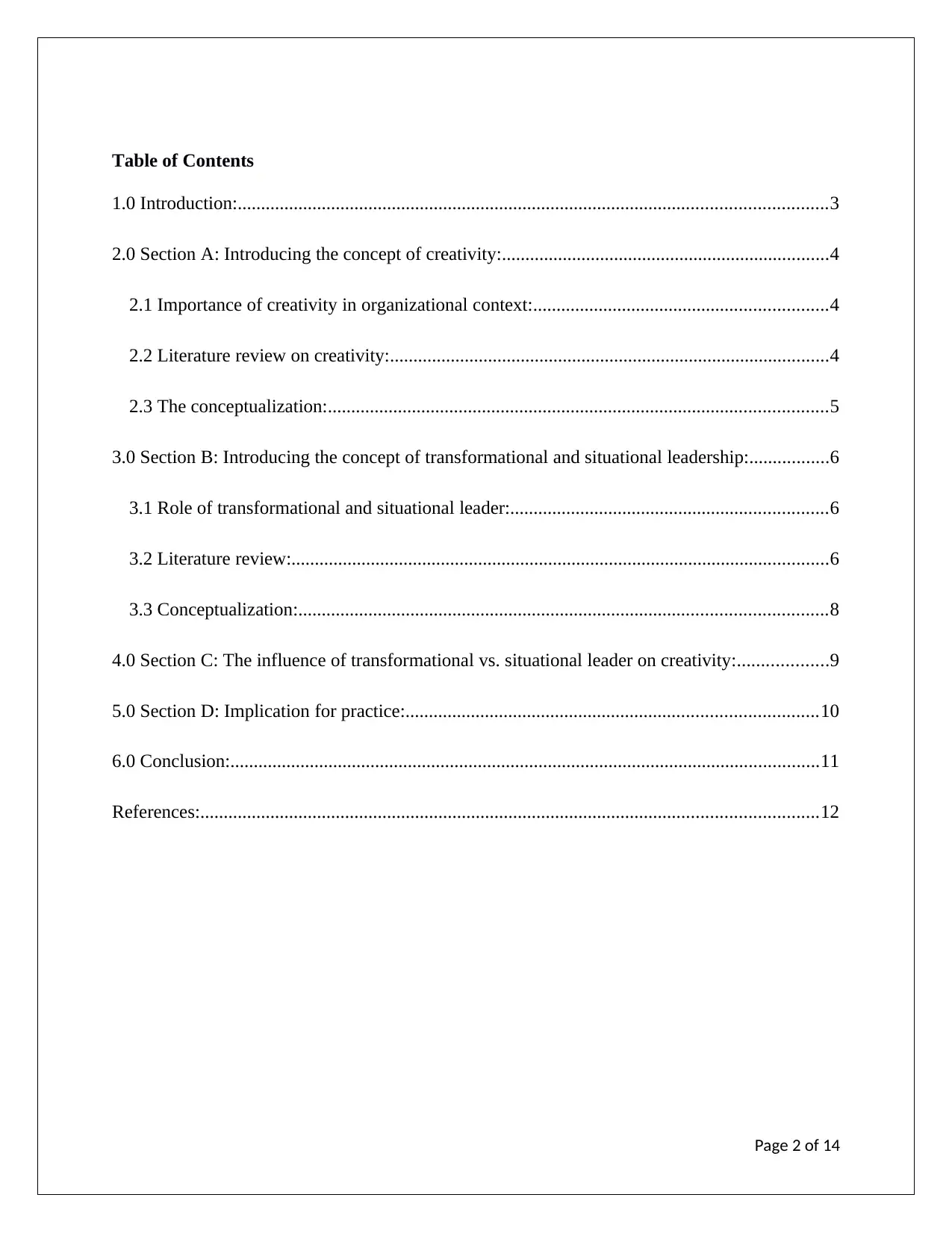
Table of Contents
1.0 Introduction:..............................................................................................................................3
2.0 Section A: Introducing the concept of creativity:......................................................................4
2.1 Importance of creativity in organizational context:...............................................................4
2.2 Literature review on creativity:..............................................................................................4
2.3 The conceptualization:...........................................................................................................5
3.0 Section B: Introducing the concept of transformational and situational leadership:.................6
3.1 Role of transformational and situational leader:....................................................................6
3.2 Literature review:...................................................................................................................6
3.3 Conceptualization:.................................................................................................................8
4.0 Section C: The influence of transformational vs. situational leader on creativity:...................9
5.0 Section D: Implication for practice:........................................................................................10
6.0 Conclusion:..............................................................................................................................11
References:....................................................................................................................................12
Page 2 of 14
1.0 Introduction:..............................................................................................................................3
2.0 Section A: Introducing the concept of creativity:......................................................................4
2.1 Importance of creativity in organizational context:...............................................................4
2.2 Literature review on creativity:..............................................................................................4
2.3 The conceptualization:...........................................................................................................5
3.0 Section B: Introducing the concept of transformational and situational leadership:.................6
3.1 Role of transformational and situational leader:....................................................................6
3.2 Literature review:...................................................................................................................6
3.3 Conceptualization:.................................................................................................................8
4.0 Section C: The influence of transformational vs. situational leader on creativity:...................9
5.0 Section D: Implication for practice:........................................................................................10
6.0 Conclusion:..............................................................................................................................11
References:....................................................................................................................................12
Page 2 of 14
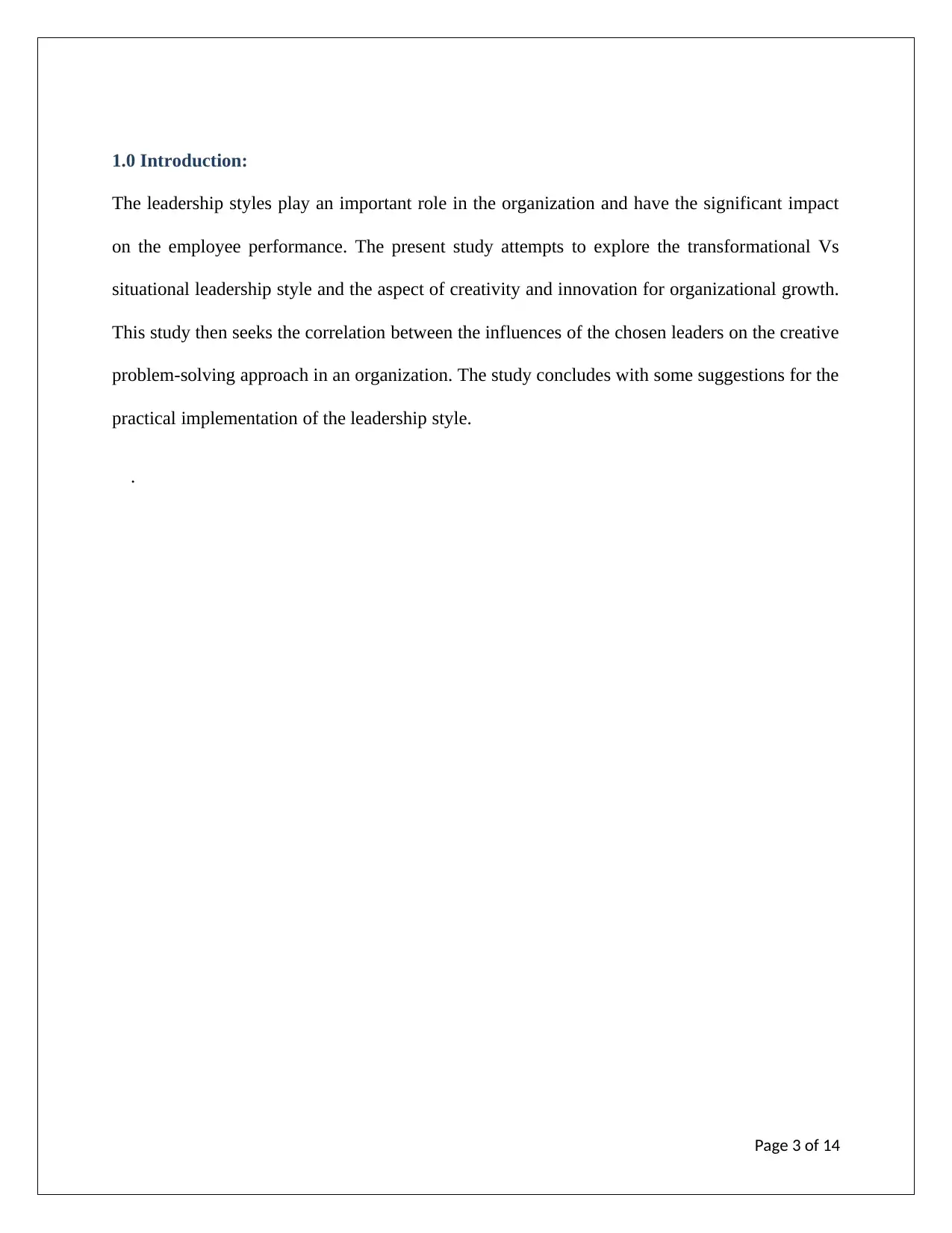
1.0 Introduction:
The leadership styles play an important role in the organization and have the significant impact
on the employee performance. The present study attempts to explore the transformational Vs
situational leadership style and the aspect of creativity and innovation for organizational growth.
This study then seeks the correlation between the influences of the chosen leaders on the creative
problem-solving approach in an organization. The study concludes with some suggestions for the
practical implementation of the leadership style.
.
Page 3 of 14
The leadership styles play an important role in the organization and have the significant impact
on the employee performance. The present study attempts to explore the transformational Vs
situational leadership style and the aspect of creativity and innovation for organizational growth.
This study then seeks the correlation between the influences of the chosen leaders on the creative
problem-solving approach in an organization. The study concludes with some suggestions for the
practical implementation of the leadership style.
.
Page 3 of 14
⊘ This is a preview!⊘
Do you want full access?
Subscribe today to unlock all pages.

Trusted by 1+ million students worldwide
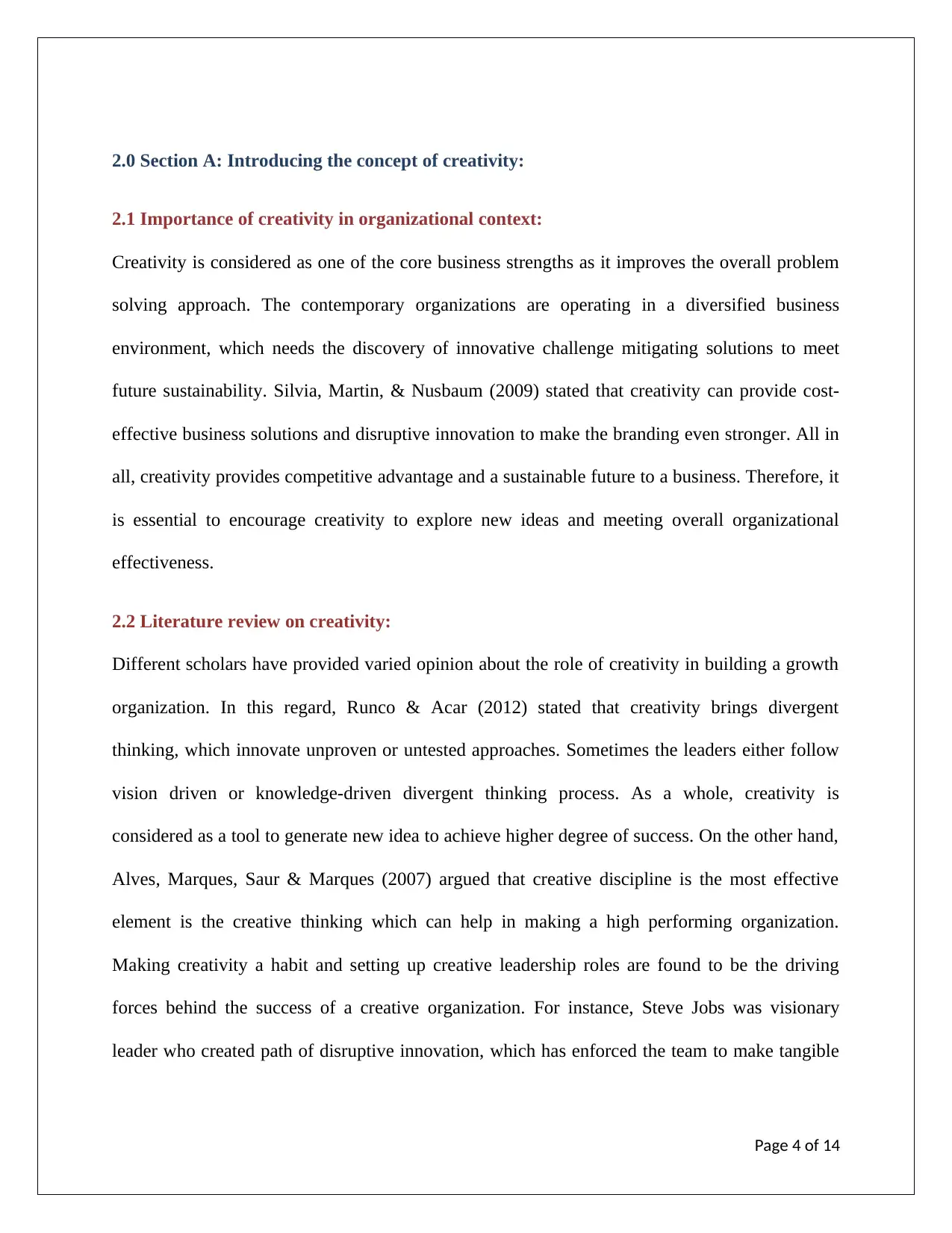
2.0 Section A: Introducing the concept of creativity:
2.1 Importance of creativity in organizational context:
Creativity is considered as one of the core business strengths as it improves the overall problem
solving approach. The contemporary organizations are operating in a diversified business
environment, which needs the discovery of innovative challenge mitigating solutions to meet
future sustainability. Silvia, Martin, & Nusbaum (2009) stated that creativity can provide cost-
effective business solutions and disruptive innovation to make the branding even stronger. All in
all, creativity provides competitive advantage and a sustainable future to a business. Therefore, it
is essential to encourage creativity to explore new ideas and meeting overall organizational
effectiveness.
2.2 Literature review on creativity:
Different scholars have provided varied opinion about the role of creativity in building a growth
organization. In this regard, Runco & Acar (2012) stated that creativity brings divergent
thinking, which innovate unproven or untested approaches. Sometimes the leaders either follow
vision driven or knowledge-driven divergent thinking process. As a whole, creativity is
considered as a tool to generate new idea to achieve higher degree of success. On the other hand,
Alves, Marques, Saur & Marques (2007) argued that creative discipline is the most effective
element is the creative thinking which can help in making a high performing organization.
Making creativity a habit and setting up creative leadership roles are found to be the driving
forces behind the success of a creative organization. For instance, Steve Jobs was visionary
leader who created path of disruptive innovation, which has enforced the team to make tangible
Page 4 of 14
2.1 Importance of creativity in organizational context:
Creativity is considered as one of the core business strengths as it improves the overall problem
solving approach. The contemporary organizations are operating in a diversified business
environment, which needs the discovery of innovative challenge mitigating solutions to meet
future sustainability. Silvia, Martin, & Nusbaum (2009) stated that creativity can provide cost-
effective business solutions and disruptive innovation to make the branding even stronger. All in
all, creativity provides competitive advantage and a sustainable future to a business. Therefore, it
is essential to encourage creativity to explore new ideas and meeting overall organizational
effectiveness.
2.2 Literature review on creativity:
Different scholars have provided varied opinion about the role of creativity in building a growth
organization. In this regard, Runco & Acar (2012) stated that creativity brings divergent
thinking, which innovate unproven or untested approaches. Sometimes the leaders either follow
vision driven or knowledge-driven divergent thinking process. As a whole, creativity is
considered as a tool to generate new idea to achieve higher degree of success. On the other hand,
Alves, Marques, Saur & Marques (2007) argued that creative discipline is the most effective
element is the creative thinking which can help in making a high performing organization.
Making creativity a habit and setting up creative leadership roles are found to be the driving
forces behind the success of a creative organization. For instance, Steve Jobs was visionary
leader who created path of disruptive innovation, which has enforced the team to make tangible
Page 4 of 14
Paraphrase This Document
Need a fresh take? Get an instant paraphrase of this document with our AI Paraphraser
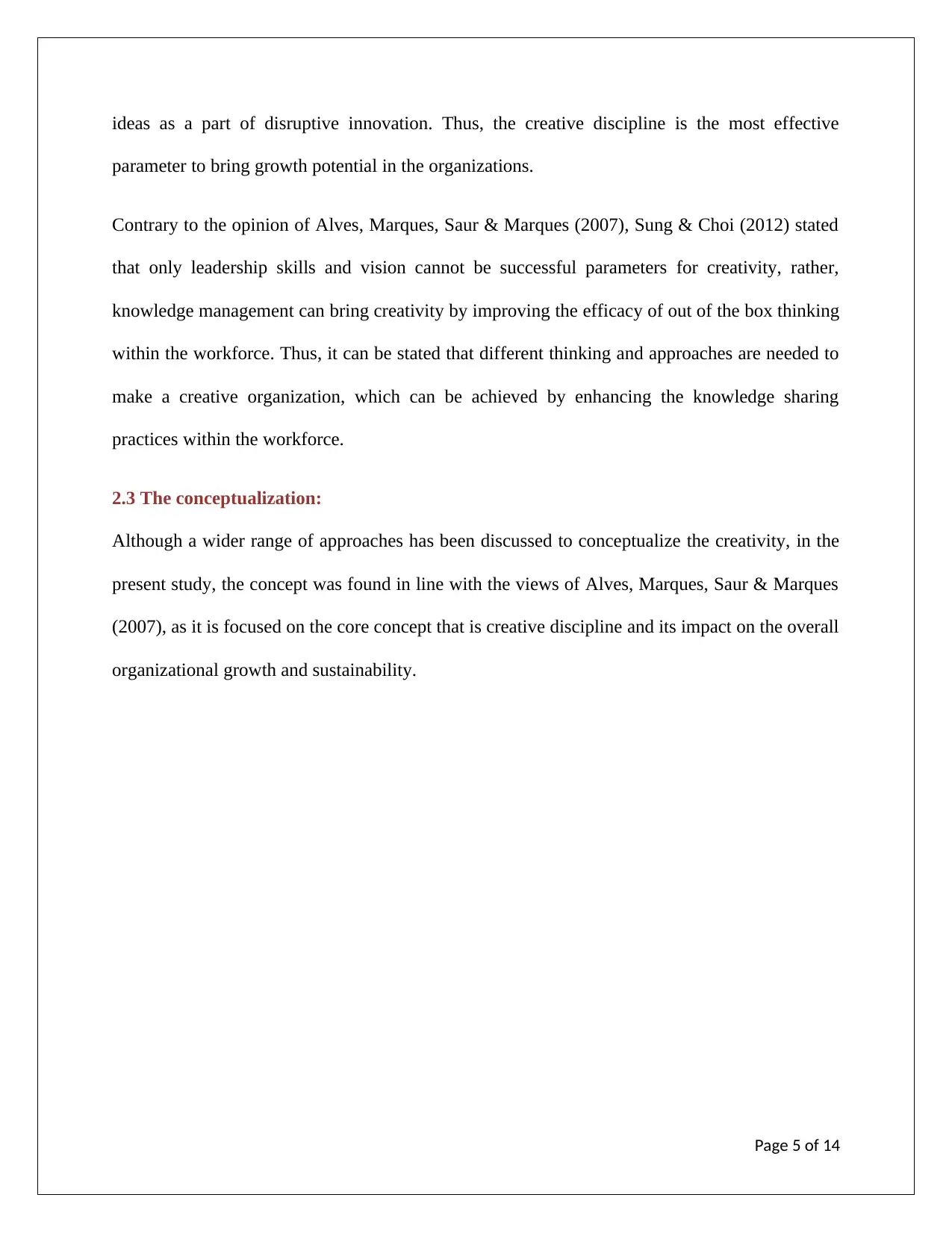
ideas as a part of disruptive innovation. Thus, the creative discipline is the most effective
parameter to bring growth potential in the organizations.
Contrary to the opinion of Alves, Marques, Saur & Marques (2007), Sung & Choi (2012) stated
that only leadership skills and vision cannot be successful parameters for creativity, rather,
knowledge management can bring creativity by improving the efficacy of out of the box thinking
within the workforce. Thus, it can be stated that different thinking and approaches are needed to
make a creative organization, which can be achieved by enhancing the knowledge sharing
practices within the workforce.
2.3 The conceptualization:
Although a wider range of approaches has been discussed to conceptualize the creativity, in the
present study, the concept was found in line with the views of Alves, Marques, Saur & Marques
(2007), as it is focused on the core concept that is creative discipline and its impact on the overall
organizational growth and sustainability.
Page 5 of 14
parameter to bring growth potential in the organizations.
Contrary to the opinion of Alves, Marques, Saur & Marques (2007), Sung & Choi (2012) stated
that only leadership skills and vision cannot be successful parameters for creativity, rather,
knowledge management can bring creativity by improving the efficacy of out of the box thinking
within the workforce. Thus, it can be stated that different thinking and approaches are needed to
make a creative organization, which can be achieved by enhancing the knowledge sharing
practices within the workforce.
2.3 The conceptualization:
Although a wider range of approaches has been discussed to conceptualize the creativity, in the
present study, the concept was found in line with the views of Alves, Marques, Saur & Marques
(2007), as it is focused on the core concept that is creative discipline and its impact on the overall
organizational growth and sustainability.
Page 5 of 14
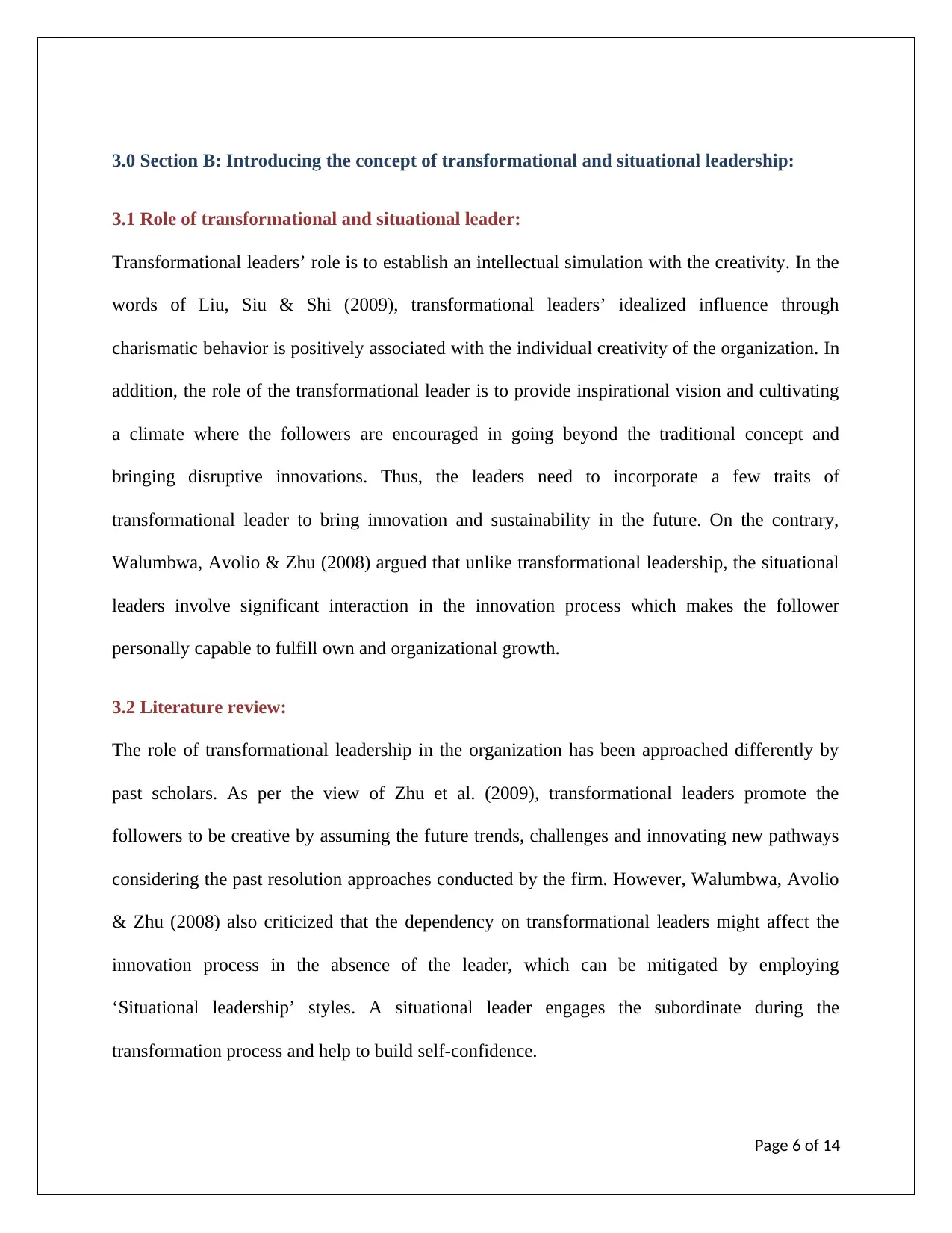
3.0 Section B: Introducing the concept of transformational and situational leadership:
3.1 Role of transformational and situational leader:
Transformational leaders’ role is to establish an intellectual simulation with the creativity. In the
words of Liu, Siu & Shi (2009), transformational leaders’ idealized influence through
charismatic behavior is positively associated with the individual creativity of the organization. In
addition, the role of the transformational leader is to provide inspirational vision and cultivating
a climate where the followers are encouraged in going beyond the traditional concept and
bringing disruptive innovations. Thus, the leaders need to incorporate a few traits of
transformational leader to bring innovation and sustainability in the future. On the contrary,
Walumbwa, Avolio & Zhu (2008) argued that unlike transformational leadership, the situational
leaders involve significant interaction in the innovation process which makes the follower
personally capable to fulfill own and organizational growth.
3.2 Literature review:
The role of transformational leadership in the organization has been approached differently by
past scholars. As per the view of Zhu et al. (2009), transformational leaders promote the
followers to be creative by assuming the future trends, challenges and innovating new pathways
considering the past resolution approaches conducted by the firm. However, Walumbwa, Avolio
& Zhu (2008) also criticized that the dependency on transformational leaders might affect the
innovation process in the absence of the leader, which can be mitigated by employing
‘Situational leadership’ styles. A situational leader engages the subordinate during the
transformation process and help to build self-confidence.
Page 6 of 14
3.1 Role of transformational and situational leader:
Transformational leaders’ role is to establish an intellectual simulation with the creativity. In the
words of Liu, Siu & Shi (2009), transformational leaders’ idealized influence through
charismatic behavior is positively associated with the individual creativity of the organization. In
addition, the role of the transformational leader is to provide inspirational vision and cultivating
a climate where the followers are encouraged in going beyond the traditional concept and
bringing disruptive innovations. Thus, the leaders need to incorporate a few traits of
transformational leader to bring innovation and sustainability in the future. On the contrary,
Walumbwa, Avolio & Zhu (2008) argued that unlike transformational leadership, the situational
leaders involve significant interaction in the innovation process which makes the follower
personally capable to fulfill own and organizational growth.
3.2 Literature review:
The role of transformational leadership in the organization has been approached differently by
past scholars. As per the view of Zhu et al. (2009), transformational leaders promote the
followers to be creative by assuming the future trends, challenges and innovating new pathways
considering the past resolution approaches conducted by the firm. However, Walumbwa, Avolio
& Zhu (2008) also criticized that the dependency on transformational leaders might affect the
innovation process in the absence of the leader, which can be mitigated by employing
‘Situational leadership’ styles. A situational leader engages the subordinate during the
transformation process and help to build self-confidence.
Page 6 of 14
⊘ This is a preview!⊘
Do you want full access?
Subscribe today to unlock all pages.

Trusted by 1+ million students worldwide
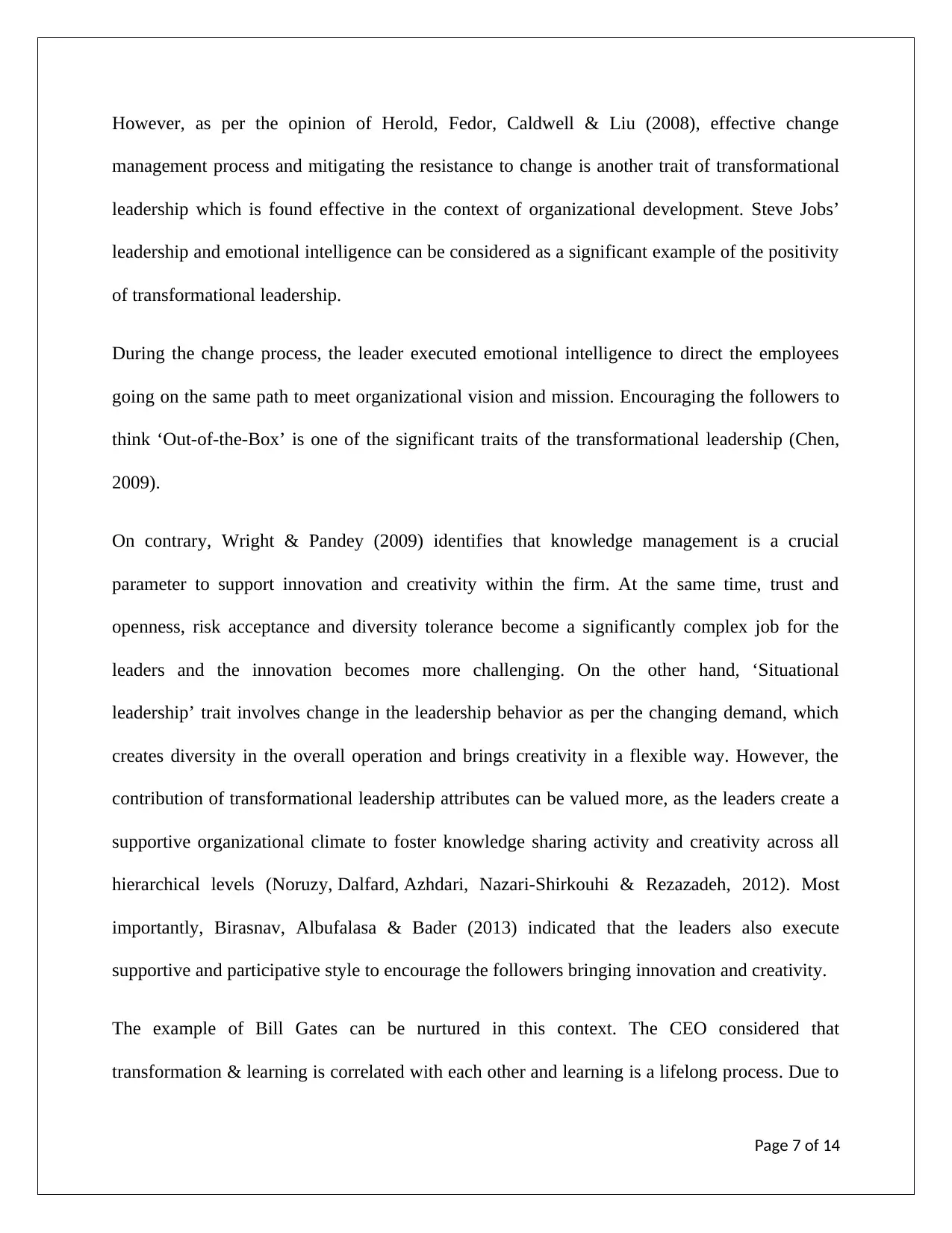
However, as per the opinion of Herold, Fedor, Caldwell & Liu (2008), effective change
management process and mitigating the resistance to change is another trait of transformational
leadership which is found effective in the context of organizational development. Steve Jobs’
leadership and emotional intelligence can be considered as a significant example of the positivity
of transformational leadership.
During the change process, the leader executed emotional intelligence to direct the employees
going on the same path to meet organizational vision and mission. Encouraging the followers to
think ‘Out-of-the-Box’ is one of the significant traits of the transformational leadership (Chen,
2009).
On contrary, Wright & Pandey (2009) identifies that knowledge management is a crucial
parameter to support innovation and creativity within the firm. At the same time, trust and
openness, risk acceptance and diversity tolerance become a significantly complex job for the
leaders and the innovation becomes more challenging. On the other hand, ‘Situational
leadership’ trait involves change in the leadership behavior as per the changing demand, which
creates diversity in the overall operation and brings creativity in a flexible way. However, the
contribution of transformational leadership attributes can be valued more, as the leaders create a
supportive organizational climate to foster knowledge sharing activity and creativity across all
hierarchical levels (Noruzy, Dalfard, Azhdari, Nazari-Shirkouhi & Rezazadeh, 2012). Most
importantly, Birasnav, Albufalasa & Bader (2013) indicated that the leaders also execute
supportive and participative style to encourage the followers bringing innovation and creativity.
The example of Bill Gates can be nurtured in this context. The CEO considered that
transformation & learning is correlated with each other and learning is a lifelong process. Due to
Page 7 of 14
management process and mitigating the resistance to change is another trait of transformational
leadership which is found effective in the context of organizational development. Steve Jobs’
leadership and emotional intelligence can be considered as a significant example of the positivity
of transformational leadership.
During the change process, the leader executed emotional intelligence to direct the employees
going on the same path to meet organizational vision and mission. Encouraging the followers to
think ‘Out-of-the-Box’ is one of the significant traits of the transformational leadership (Chen,
2009).
On contrary, Wright & Pandey (2009) identifies that knowledge management is a crucial
parameter to support innovation and creativity within the firm. At the same time, trust and
openness, risk acceptance and diversity tolerance become a significantly complex job for the
leaders and the innovation becomes more challenging. On the other hand, ‘Situational
leadership’ trait involves change in the leadership behavior as per the changing demand, which
creates diversity in the overall operation and brings creativity in a flexible way. However, the
contribution of transformational leadership attributes can be valued more, as the leaders create a
supportive organizational climate to foster knowledge sharing activity and creativity across all
hierarchical levels (Noruzy, Dalfard, Azhdari, Nazari-Shirkouhi & Rezazadeh, 2012). Most
importantly, Birasnav, Albufalasa & Bader (2013) indicated that the leaders also execute
supportive and participative style to encourage the followers bringing innovation and creativity.
The example of Bill Gates can be nurtured in this context. The CEO considered that
transformation & learning is correlated with each other and learning is a lifelong process. Due to
Page 7 of 14
Paraphrase This Document
Need a fresh take? Get an instant paraphrase of this document with our AI Paraphraser
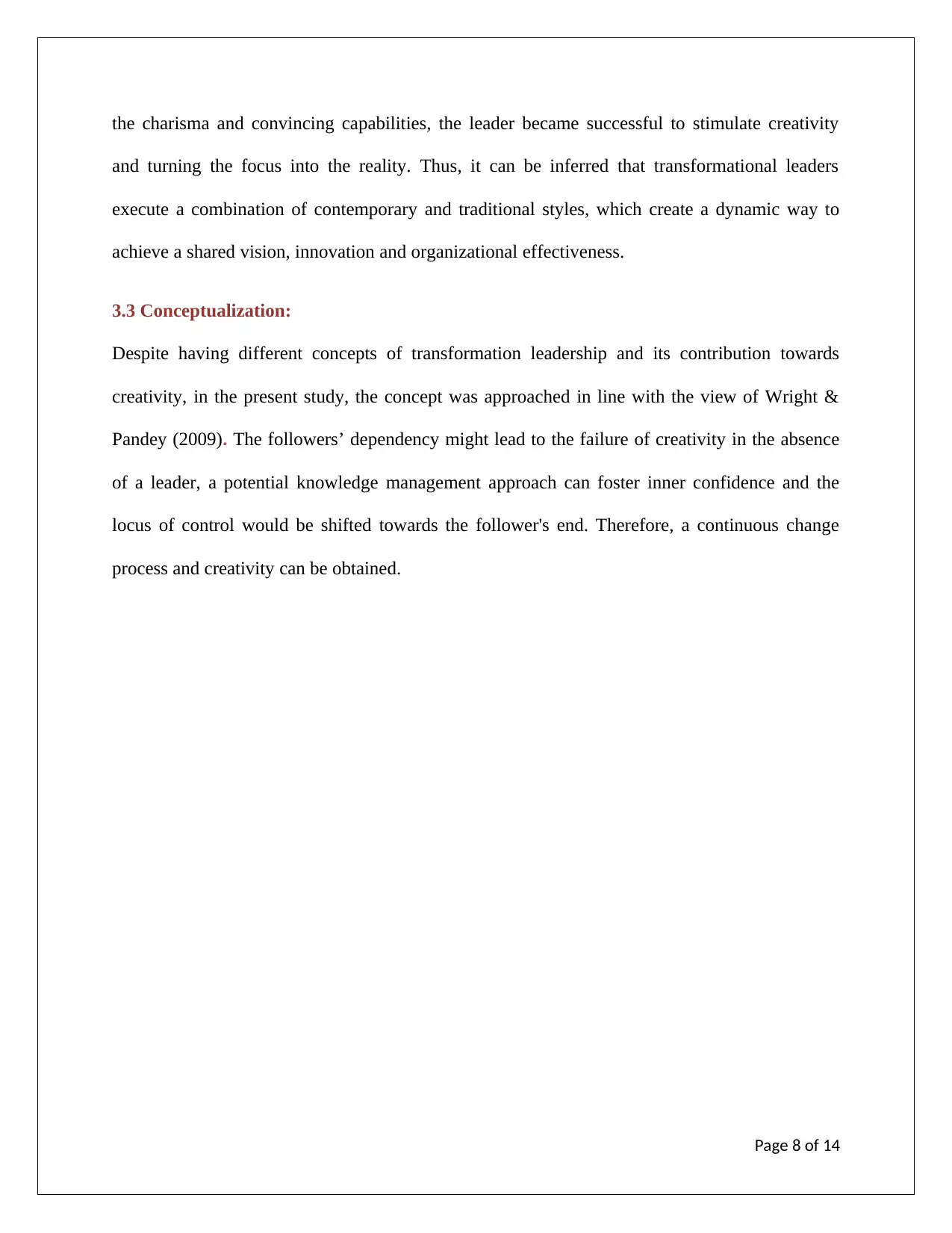
the charisma and convincing capabilities, the leader became successful to stimulate creativity
and turning the focus into the reality. Thus, it can be inferred that transformational leaders
execute a combination of contemporary and traditional styles, which create a dynamic way to
achieve a shared vision, innovation and organizational effectiveness.
3.3 Conceptualization:
Despite having different concepts of transformation leadership and its contribution towards
creativity, in the present study, the concept was approached in line with the view of Wright &
Pandey (2009). The followers’ dependency might lead to the failure of creativity in the absence
of a leader, a potential knowledge management approach can foster inner confidence and the
locus of control would be shifted towards the follower's end. Therefore, a continuous change
process and creativity can be obtained.
Page 8 of 14
and turning the focus into the reality. Thus, it can be inferred that transformational leaders
execute a combination of contemporary and traditional styles, which create a dynamic way to
achieve a shared vision, innovation and organizational effectiveness.
3.3 Conceptualization:
Despite having different concepts of transformation leadership and its contribution towards
creativity, in the present study, the concept was approached in line with the view of Wright &
Pandey (2009). The followers’ dependency might lead to the failure of creativity in the absence
of a leader, a potential knowledge management approach can foster inner confidence and the
locus of control would be shifted towards the follower's end. Therefore, a continuous change
process and creativity can be obtained.
Page 8 of 14
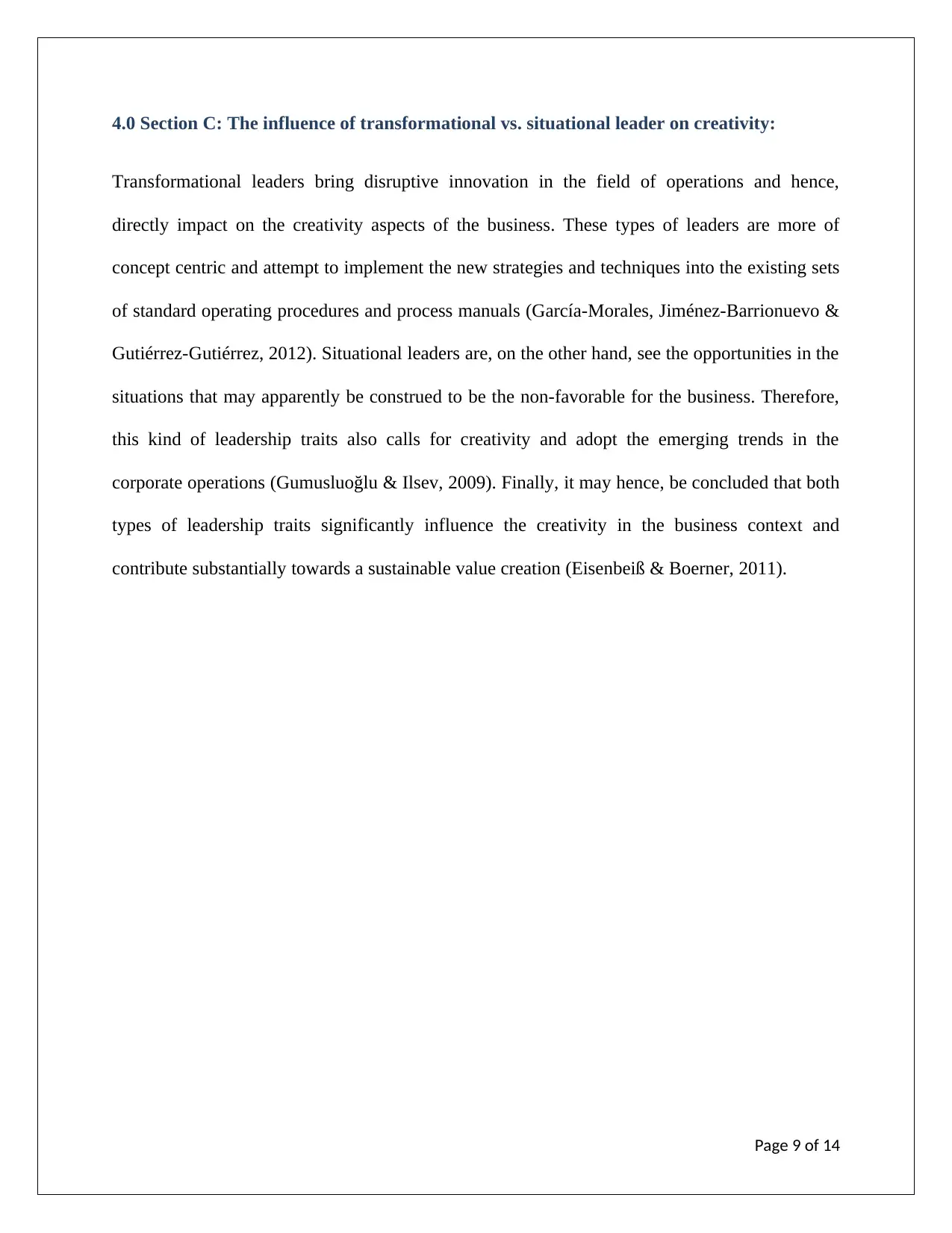
4.0 Section C: The influence of transformational vs. situational leader on creativity:
Transformational leaders bring disruptive innovation in the field of operations and hence,
directly impact on the creativity aspects of the business. These types of leaders are more of
concept centric and attempt to implement the new strategies and techniques into the existing sets
of standard operating procedures and process manuals (García-Morales, Jiménez-Barrionuevo &
Gutiérrez-Gutiérrez, 2012). Situational leaders are, on the other hand, see the opportunities in the
situations that may apparently be construed to be the non-favorable for the business. Therefore,
this kind of leadership traits also calls for creativity and adopt the emerging trends in the
corporate operations (Gumusluoğlu & Ilsev, 2009). Finally, it may hence, be concluded that both
types of leadership traits significantly influence the creativity in the business context and
contribute substantially towards a sustainable value creation (Eisenbeiß & Boerner, 2011).
Page 9 of 14
Transformational leaders bring disruptive innovation in the field of operations and hence,
directly impact on the creativity aspects of the business. These types of leaders are more of
concept centric and attempt to implement the new strategies and techniques into the existing sets
of standard operating procedures and process manuals (García-Morales, Jiménez-Barrionuevo &
Gutiérrez-Gutiérrez, 2012). Situational leaders are, on the other hand, see the opportunities in the
situations that may apparently be construed to be the non-favorable for the business. Therefore,
this kind of leadership traits also calls for creativity and adopt the emerging trends in the
corporate operations (Gumusluoğlu & Ilsev, 2009). Finally, it may hence, be concluded that both
types of leadership traits significantly influence the creativity in the business context and
contribute substantially towards a sustainable value creation (Eisenbeiß & Boerner, 2011).
Page 9 of 14
⊘ This is a preview!⊘
Do you want full access?
Subscribe today to unlock all pages.

Trusted by 1+ million students worldwide
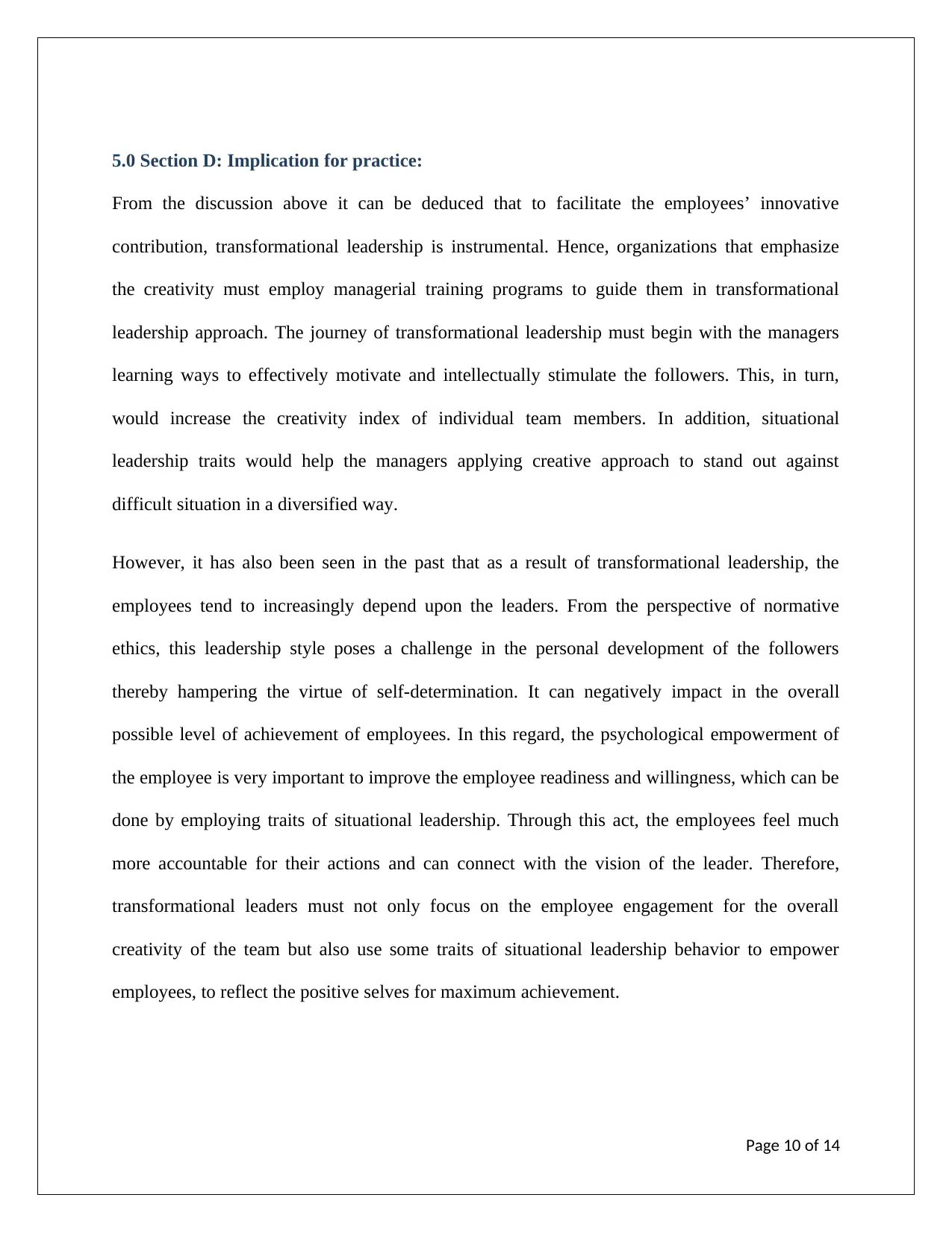
5.0 Section D: Implication for practice:
From the discussion above it can be deduced that to facilitate the employees’ innovative
contribution, transformational leadership is instrumental. Hence, organizations that emphasize
the creativity must employ managerial training programs to guide them in transformational
leadership approach. The journey of transformational leadership must begin with the managers
learning ways to effectively motivate and intellectually stimulate the followers. This, in turn,
would increase the creativity index of individual team members. In addition, situational
leadership traits would help the managers applying creative approach to stand out against
difficult situation in a diversified way.
However, it has also been seen in the past that as a result of transformational leadership, the
employees tend to increasingly depend upon the leaders. From the perspective of normative
ethics, this leadership style poses a challenge in the personal development of the followers
thereby hampering the virtue of self-determination. It can negatively impact in the overall
possible level of achievement of employees. In this regard, the psychological empowerment of
the employee is very important to improve the employee readiness and willingness, which can be
done by employing traits of situational leadership. Through this act, the employees feel much
more accountable for their actions and can connect with the vision of the leader. Therefore,
transformational leaders must not only focus on the employee engagement for the overall
creativity of the team but also use some traits of situational leadership behavior to empower
employees, to reflect the positive selves for maximum achievement.
Page 10 of 14
From the discussion above it can be deduced that to facilitate the employees’ innovative
contribution, transformational leadership is instrumental. Hence, organizations that emphasize
the creativity must employ managerial training programs to guide them in transformational
leadership approach. The journey of transformational leadership must begin with the managers
learning ways to effectively motivate and intellectually stimulate the followers. This, in turn,
would increase the creativity index of individual team members. In addition, situational
leadership traits would help the managers applying creative approach to stand out against
difficult situation in a diversified way.
However, it has also been seen in the past that as a result of transformational leadership, the
employees tend to increasingly depend upon the leaders. From the perspective of normative
ethics, this leadership style poses a challenge in the personal development of the followers
thereby hampering the virtue of self-determination. It can negatively impact in the overall
possible level of achievement of employees. In this regard, the psychological empowerment of
the employee is very important to improve the employee readiness and willingness, which can be
done by employing traits of situational leadership. Through this act, the employees feel much
more accountable for their actions and can connect with the vision of the leader. Therefore,
transformational leaders must not only focus on the employee engagement for the overall
creativity of the team but also use some traits of situational leadership behavior to empower
employees, to reflect the positive selves for maximum achievement.
Page 10 of 14
Paraphrase This Document
Need a fresh take? Get an instant paraphrase of this document with our AI Paraphraser
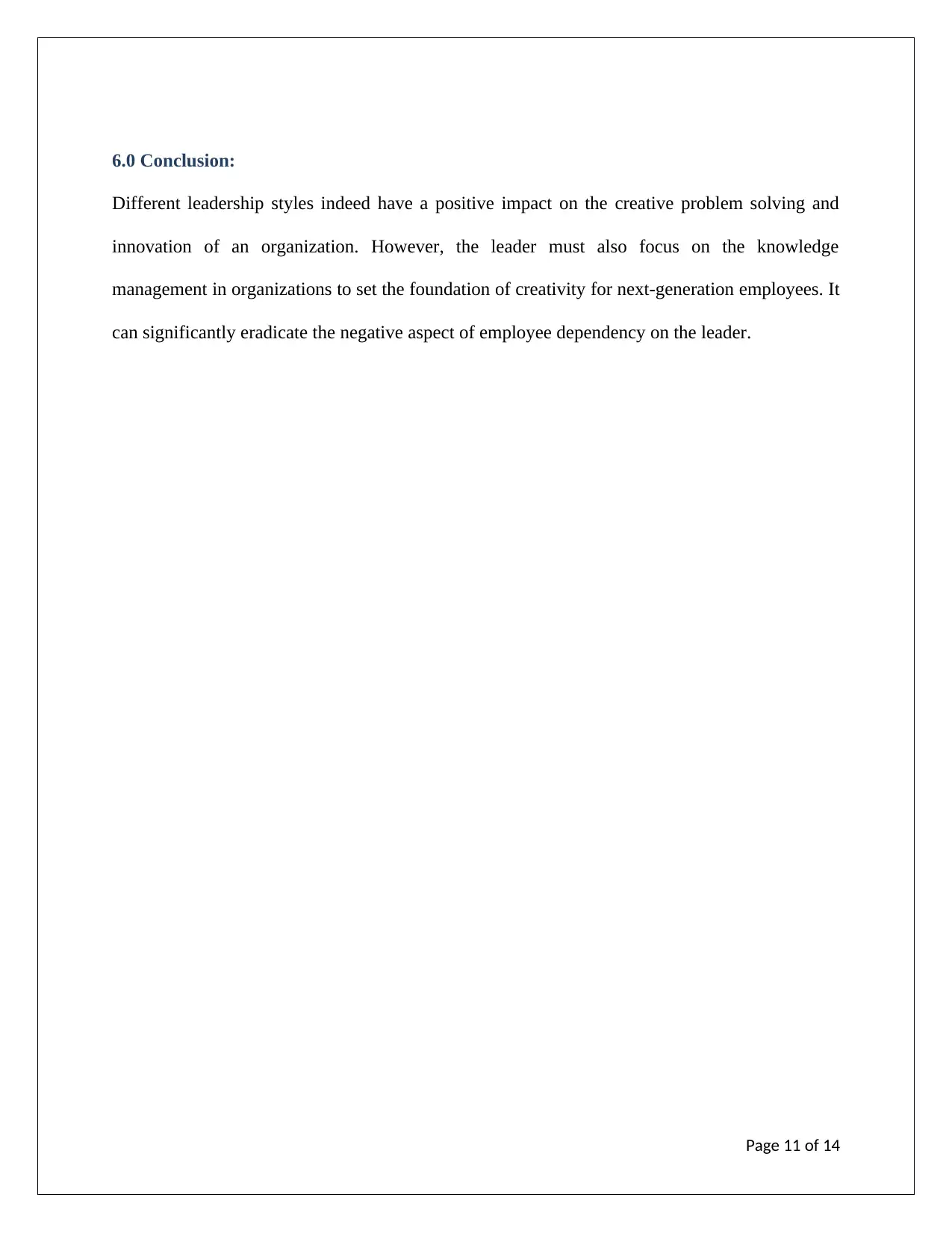
6.0 Conclusion:
Different leadership styles indeed have a positive impact on the creative problem solving and
innovation of an organization. However, the leader must also focus on the knowledge
management in organizations to set the foundation of creativity for next-generation employees. It
can significantly eradicate the negative aspect of employee dependency on the leader.
Page 11 of 14
Different leadership styles indeed have a positive impact on the creative problem solving and
innovation of an organization. However, the leader must also focus on the knowledge
management in organizations to set the foundation of creativity for next-generation employees. It
can significantly eradicate the negative aspect of employee dependency on the leader.
Page 11 of 14
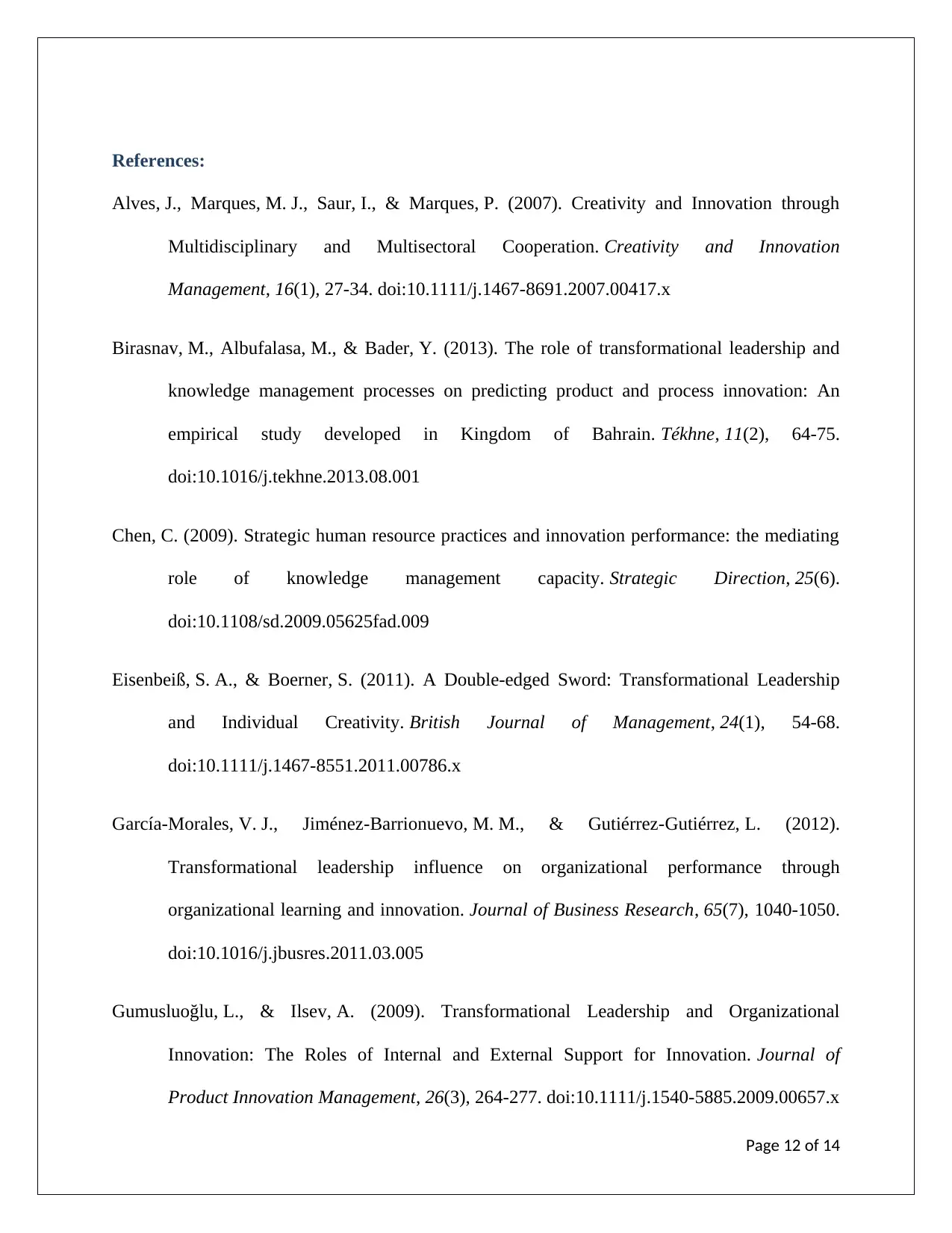
References:
Alves, J., Marques, M. J., Saur, I., & Marques, P. (2007). Creativity and Innovation through
Multidisciplinary and Multisectoral Cooperation. Creativity and Innovation
Management, 16(1), 27-34. doi:10.1111/j.1467-8691.2007.00417.x
Birasnav, M., Albufalasa, M., & Bader, Y. (2013). The role of transformational leadership and
knowledge management processes on predicting product and process innovation: An
empirical study developed in Kingdom of Bahrain. Tékhne, 11(2), 64-75.
doi:10.1016/j.tekhne.2013.08.001
Chen, C. (2009). Strategic human resource practices and innovation performance: the mediating
role of knowledge management capacity. Strategic Direction, 25(6).
doi:10.1108/sd.2009.05625fad.009
Eisenbeiß, S. A., & Boerner, S. (2011). A Double-edged Sword: Transformational Leadership
and Individual Creativity. British Journal of Management, 24(1), 54-68.
doi:10.1111/j.1467-8551.2011.00786.x
García-Morales, V. J., Jiménez-Barrionuevo, M. M., & Gutiérrez-Gutiérrez, L. (2012).
Transformational leadership influence on organizational performance through
organizational learning and innovation. Journal of Business Research, 65(7), 1040-1050.
doi:10.1016/j.jbusres.2011.03.005
Gumusluoğlu, L., & Ilsev, A. (2009). Transformational Leadership and Organizational
Innovation: The Roles of Internal and External Support for Innovation. Journal of
Product Innovation Management, 26(3), 264-277. doi:10.1111/j.1540-5885.2009.00657.x
Page 12 of 14
Alves, J., Marques, M. J., Saur, I., & Marques, P. (2007). Creativity and Innovation through
Multidisciplinary and Multisectoral Cooperation. Creativity and Innovation
Management, 16(1), 27-34. doi:10.1111/j.1467-8691.2007.00417.x
Birasnav, M., Albufalasa, M., & Bader, Y. (2013). The role of transformational leadership and
knowledge management processes on predicting product and process innovation: An
empirical study developed in Kingdom of Bahrain. Tékhne, 11(2), 64-75.
doi:10.1016/j.tekhne.2013.08.001
Chen, C. (2009). Strategic human resource practices and innovation performance: the mediating
role of knowledge management capacity. Strategic Direction, 25(6).
doi:10.1108/sd.2009.05625fad.009
Eisenbeiß, S. A., & Boerner, S. (2011). A Double-edged Sword: Transformational Leadership
and Individual Creativity. British Journal of Management, 24(1), 54-68.
doi:10.1111/j.1467-8551.2011.00786.x
García-Morales, V. J., Jiménez-Barrionuevo, M. M., & Gutiérrez-Gutiérrez, L. (2012).
Transformational leadership influence on organizational performance through
organizational learning and innovation. Journal of Business Research, 65(7), 1040-1050.
doi:10.1016/j.jbusres.2011.03.005
Gumusluoğlu, L., & Ilsev, A. (2009). Transformational Leadership and Organizational
Innovation: The Roles of Internal and External Support for Innovation. Journal of
Product Innovation Management, 26(3), 264-277. doi:10.1111/j.1540-5885.2009.00657.x
Page 12 of 14
⊘ This is a preview!⊘
Do you want full access?
Subscribe today to unlock all pages.

Trusted by 1+ million students worldwide
1 out of 14
Related Documents
Your All-in-One AI-Powered Toolkit for Academic Success.
+13062052269
info@desklib.com
Available 24*7 on WhatsApp / Email
![[object Object]](/_next/static/media/star-bottom.7253800d.svg)
Unlock your academic potential
Copyright © 2020–2025 A2Z Services. All Rights Reserved. Developed and managed by ZUCOL.



